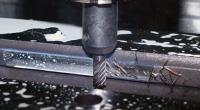 Add My Company
Add My Company
Sign In

A deep hole is defined by the depth-to-diameter ratio and every hole larger than a ratio of 10:1 is considered deep. There are lots of applications for deep hole drilling across many industries, with the origins tracing back to gun barrels. Deep hole drilling is used in different materials and can help achieve a tight diameter, straightness, and a perfect surface finish.
Deep hole drilling is done on special deep hole drilling machines, which are assembled to ensure efficiency, straightness, and precise drilling. Modern technology allows for gundrilling of small diameter holes over long lengths.
However, drilling a straight hole and exactly where you need it isn't always easy. A drill can be difficult to control while maintaining accuracy, especially when particularly deep holes are required. Luckily, there are proven techniques and reliable equipment now available to ensure engineers achieve a precise result.
Find The Centre And Drill On Target
Position is everything – on or off centre, accuracy at the start improves the quality of the entire process.
To assist, there are centring tools and fixtures that can help when setting the machine. Self-centring bits help centre the bit in the machined hole by guiding the tool to the correct location but it can be as easy as simply marking with a cross!
Contra-Rotation
After ensuring the most accurate start point for drilling, the most accurate way of minimising drill wander is to contra-rotate the component. This means that the part will be rotating one way when held in the chuck and the gundrilling tool will be rotated in the opposite direction ensuring that the opposing forces come together to create a bore as straight as possible. In some cases, i.e. in block or PCD work, this is not always possible and therefore the standard industry parameters for deep hole drilling will always be quoted. These are 1mm of wander for every 1 metre drilling or 0.001” per 1” drilled. This means that if set correctly, your start hole will be perfectly accurate, the hole will be dead straight but the exit point will be at worst, 1mm off centre in a 1 metre long component. Gundrilling cannot create a bent hole, this is a common misconception. However, the hole can wander off centre from the original start line.
Clear The Swarf Often
How the swarf chips and the effectiveness of its removal can also cause a drill to wander, which can result in oversized holes or even broken drills. The tips and / or the swarf can get trapped in the bore or twisted around the drill and you will have to spend lots of time clearing it. To avoid this, an engineer should watch the swarf carefully and based on its characteristics, adjust the feeds and speeds to improve the chipping effect.
The Hardening Effect When Drilling Stainless Steel
When drilling certain steels, the work hardening effect can also cause problems. This is when the steel slowly hardens as it is cold worked, causing the drill to wander or even cause excessive wear on the tip resulting in the creation of an oversize bore.
During deep drilling, it's vital to maintain the feed to easily cut through the steel's hardened layer. If you have to re-enter the hole after backing out, always do it at a full feed rate and speed. However, if you need to make sure the feed rate is maintained, reduce the tool speed.
For more information on How To Avoid Drill Wander When Gundrilling Or Deep Hole Boring talk to Hone-All Precision Ltd
Enquire Now
More News
List your company on FindTheNeedle.

